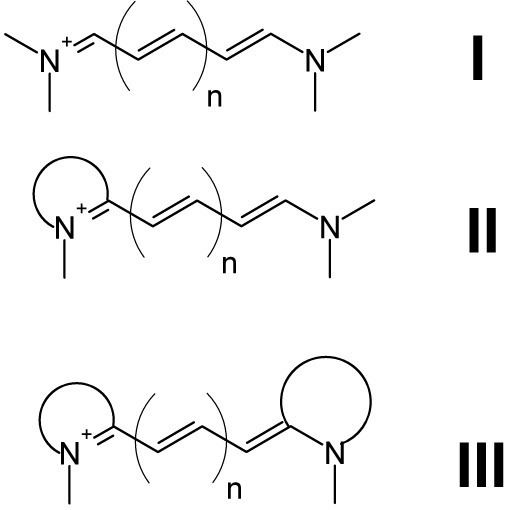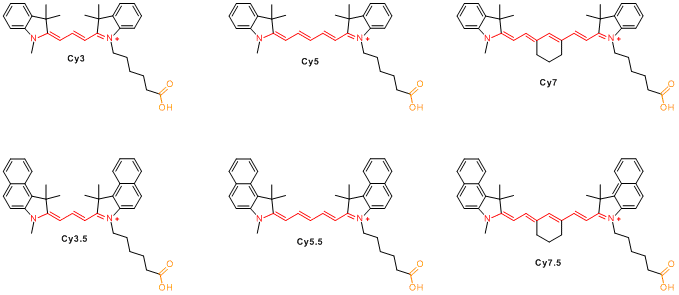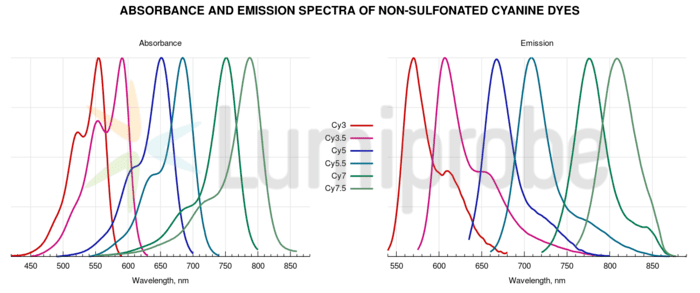 | ||
Cyanine is the non-systematic name of a synthetic dye family belonging to polymethine group. The word cyanin is from the English word “cyan", which conventionally means a shade of blue-green (close to "aqua") and is derived from the Greek “kyanos" which means a somewhat different color: "dark blue".
Contents
- Hardest song in lanota cyanine lv 15 master all combo
- Structure
- Cyanine dyes history and use in industry
- Conventional Cyanines dyes used in biotechnology
- Main Cy dyes and their uses
- Nomenclature and structure
- Cy dye alternatives
- Cy5 ozone susceptibility
- Applications
- Nucleic acid labeling
- Protein labeling
- References

Cyanines were and are still used in industry, and more recently in biotechnology (labeling, analysis). Cyanines have many uses as fluorescent dyes, particularly in biomedical imaging. Depending on the structure, they cover the spectrum from IR to UV. There are a large number reported in the literature.

Hardest song in lanota cyanine lv 15 master all combo
Structure
There are three types of cyanines:

where two nitrogens are joined by a polymethine chain. Both nitrogens are each independently part of a heteroaromatic moiety, such as pyrrole, imidazole, thiazole, pyridine, quinoline, indole, benzothiazole, etc.
Cyanine dyes history, and use in industry

Cyanines were first synthesized over a century ago. They were originally used, and still are, to increase the sensitivity range of photographic emulsions, i.e., to increase the range of wavelengths which will form an image on the film, making the film panchromatic. Cyanines are also used in CD-R and DVD-R media. The ones used are mostly green or light blue in color, and are chemically unstable. This makes unstabilized cyanine discs unsuitable for archival CD and DVD use, as they can fade and become unreadable in a few years, however, recent cyanine discs contain stabilizers that slow down the deterioration significantly. These discs are often rated with an archival life of 75 years or more. The other dyes used in CD-Rs are phthalocyanine and azo.
Conventional Cyanines dyes used in biotechnology
Cyanines dyes are usually synthesized from 2, 3, 5 or 7 methine structures with reactive groups on either one or both of the nitrogen side chains so that they can be chemically linked to either nucleic acids or protein molecules. Labeling is done for visualization and quantification purposes. Biological applications include comparative genomic hybridization and gene chips, which are used in transcriptomics, and various studies in proteomics such as RNA localization, molecular interaction studies by fluorescence energy transfer (FRET) and fluorescent immunoassays.
Cyanines dyes are available with different modifications such as methyl, ethyl or butyl substituent, carboxyl, acetylmethoxy, and sulfo groups (conferring hydrophilicity).
Ex (nm): Excitation wavelength in nanometers
Em (nm): Emission wavelength in nanometers
MW: Molecular weight
QY: Quantum yield
Main Cy dyes and their uses
Cyanines(Cy) replace advantageously conventional dyes such as Fluorescein(FITC) and rhodamines (TRITC, RRX), yielding brighter and more stable fluorescence.
Cy3 fluoresces greenish yellow (~550 nm excitation, ~570 nm emission), while Cy5 is fluorescent in the red region (~650 excitation, 670 nm emission). Cy3 can be detected by various fluorometers, imagers, and microscopes with standard filters for Tetramethylrhodamine (TRITC). Due to inherently high extinction coefficient, this dye is also easily detected by naked eye on gels, and in solution. Cy5 become very popular to replace far red fluorescent dyes, because of its high extinction coefficient (as small as 1 nanomol can be detected in gel electrophoresis by naked eye) and of its fluorophore emission maximum in red region, where many CCD detectors have maximum sensitivity, and biological objects have low background.
The scanners actually use different laser emission wavelengths (typically 532 nm and 635 nm) and filter wavelengths (550-600 nm and 655-695 nm) to avoid background contamination. They are thus able to easily distinguish colors from Cy3 and from Cy5, and also able to quantify the amount of Cy3 and Cy5 labeling in one sample (multiparametric detection).
Cy3.5 can replace SulfoRhodamine 101.
Cy5.5 is a near-infrared (IR) fluorescence-emitting dye (Excitation/emission maximum 678/694 nm).
Cy7 is a near-IR fluor that is invisible to the naked eye (Excitation/emission maximum 750/776 nm). It is used in in vivo imaging applications, as well as the Cy7.5 dye.
Sulfo–Cyanine dyes bear classically one or two Sulfo groups, rendering the Cy dye water-soluble, but tri- and quadri-sulfonated forms are available for even higher hydrosolubility. PEGylation is another modification that confers hydrophilicity, not only to the dye but also to the labeled conjugate.
Nomenclature and structure
Standard chemical names specify exactly the chemical structure of the molecule. The Cy3 and Cy5 nomenclature was first proposed by Ernst, et al. in 1989, and is non-standard, since it gives no hint of their chemical structures. In the original paper the number designated the count of the methines (as shown), and the side chains were unspecified. Thus various structures are designated Cy3 and Cy5 in the literature.
The R groups do not have to be identical. In the dyes as used they are short aliphatic chains one or both of which ends in a highly reactive moiety such as N-hydroxysuccinimide or maleimide.
Cy dye alternatives
Many analogs of standard Cy 2 / 3 / 3.5 / 5 / 5.5 / 7 / 7.5 dyes were developed, using diverse modification: Alexa Fluor dyes, Dylight, FluoProbes dyes, Sulfo Cy dyes, Seta dyes, IRIS dyes from Cyanine Technologies and others can be used interchangeably with Cy dyes in most biochemical applications, with claimed improvements in solubility, fluorescence, or photostability.
Cy5 ozone susceptibility
In 2003, researchers at Inpharmatics and Agilent reported in Analytical Chemistry that microarrays which used Cy5 were susceptible to intermittent data quality decrease caused by environmental ozone. Exposures to ozone levels above 5-10 ppb for 10–30 seconds were reported to decrease the reproducibility of Cy5 microarrays. Much higher levels of ozone (>100 ppb) were required to observe an effect in Cy3. There are devices that claim to remove ambient ozone levels but they have not been 3rd party tested.
Applications
Cyanine dyes are used to label proteins, antibodies, peptides, nucleic acid probes, and any kind of other biomolecules to be used in a variety of fluorescence detection techniques: Flow cytometry, Microscopy (mainly Visible range, but also UV, IR), Microplate assays, Microarrays, ... .
Nucleic acid labeling
In microarray experiments DNA or RNA is labeled with either Cy3 or Cy5 that has been synthesized to carry an N-hydroxysuccinimidyl ester (NHS-ester) reactive group. Since NHS-esters react readily only with aliphatic amine groups, which nucleic acids lack, nucleotides have to be modified with aminoallyl groups. This is done through incorporating aminoallyl-modified nucleotides during synthesis reactions. A good ratio is a label every 60 bases such that the labels are not too close to each other, which would result in quenching effects.
Protein labeling
For protein labeling, Cy3 and Cy5 dyes sometimes bear typically a succinimidyl group to react with amines, or a maleimide group to react with a sulfhydryl group of cysteine residues.
Cy5 is sensitive to the electronic environment it resides in. Changes in the conformation of the protein it is attached to will produce either enhancement or quenching of the emission. The rate of this change can be measured to determine enzyme kinetic parameters. The dyes can be used for similar purposes in FRET experiments.
Cy3 and Cy5 are used in proteomics experiments so that samples from two sources can be mixed and run together through the separation process. This eliminates variations due to differing experimental conditions that are inevitable if the samples were run separately. These variations make it extremely difficult, if not impossible, to use computers to automate the acquisition of the data after the separation is complete. Using these dyes makes the automation trivial.
